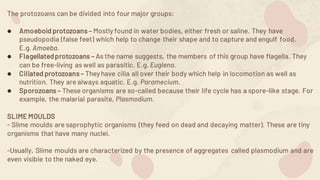The document discusses the classification of living organisms into five kingdoms: Monera, Protista, Fungi, Plantae, and Animalia, highlighting the criteria for their differentiation such as cell structure, mode of nutrition, and reproduction methods. It explains the characteristics and importance of each kingdom, including the evolution from Linnaeus' two-kingdom system and Robert Whittaker's introduction of the five-kingdom model. Additionally, it delves into the subcategories of Monera, the unique aspects of protists, fungi, and plants, emphasizing their roles in ecosystems and human life.












































